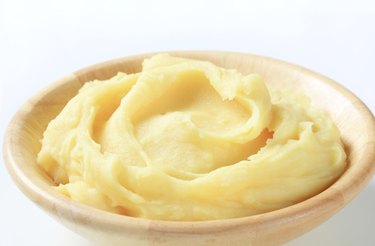
Mashing up a bowl of potatoes for dinner isn't exactly rocket science, but there's more to it than you might think. For example, if you're in a hurry and opt to use your food processor or stand mixer to mash the spuds, there's a high likelihood you'll end up with a gluey and disappointing mess. In truth you can use your Cuisinart to make mashed potatoes -- restaurants do it all the time -- but you need to understand the correct technique.
The "White Glue" Issue
Video of the Day
Potatoes become gluey when mashed too vigorously, given the starch granules that make up a large portion of their mass. When you boil potatoes, those granules become swollen and absorb water, changing their texture from the mealy crunch of a raw potato to the soft and butter-friendly texture of a cooked one. Mashing too vigorously can break open the granules, freeing the starches to thicken the potatoes to a gummy paste. It's exactly the same process you see when you add too much flour or cornstarch when making gravy. Over-mixing your potatoes by hand takes work, but in a powerful Cuisinart it requires only seconds. Avoiding the dreaded bowl full of glue is correspondingly harder when you're using a food processor or mixer.
Video of the Day
Mashed, With Russets
Russets make beautifully light and fluffy mashed, but as an unusually starchy potato they're extra-prone to gumminess. If you have time, boil your russets whole. This minimizes the amount of water they absorb during cooking and helps prevent stickiness. Once they're cooled enough to handle, remove the skins and put the coarse shredding disk into the Cuisinart. Shred the potatoes, then return them to a pot and dry them for a few minutes over the now-cooling burner of your stove.
Replace the disk in the Cuisinart with the blade, and add back the shredded potatoes. Pulse them first with a few spoonfuls of softened butter, to coat the starch molecules with protective fat. Then add the remainder of the butter, and milk or cream, and pulse or process until the potatoes have barely absorbed the add-ins.
"Pommes Purees," With Waxy Potatoes
French cooks prefer to use waxy potatoes, such as the European Bintje or North American Yukon Gold, for their smooth-textured "pommes purees." Waxy potatoes are not only more forgiving of mechanical mixing, they outright require more mixing to achieve the correct texture. Cook the potatoes and shred them coarsely, using the coarse disk of the Cuisinart. Return the potatoes to the processor's bowl and puree them briefly with part of the recipe's butter. Once it's absorbed, add the remaining butter and any milk or cream.
Famous chefs often use equal parts butter and potato by weight in their "pommes," but don't feel obliged to be that lavish. If you use at least 1 part butter to 4 of potatoes they'll be fine, and downright decadent if you use 1 part butter to 2 parts of potatoes.
Mashed In a Mixer
If your Cuisinart is a stand mixer, rather than a food processor, the procedure is less finicky. You can still shred the potatoes, if you wish, using a box grater or -- if you have one -- a potato ricer. This is a gentler way of breaking your potatoes into small pieces, so the stand mixer doesn't need to work them for nearly as long. In either case, shredded or not, transfer the cooked potatoes to the bowl of the mixer. Fit the mixer with its paddle attachment and use the slowest setting to break up the potatoes if they're not shredded. Add butter to the potatoes, and then add your milk or cream once the initial quantity of butter is absorbed. Russets are ready to serve at that stage, while waxy potatoes might require a few seconds of higher-speed mixing to create the necessary smooth texture.